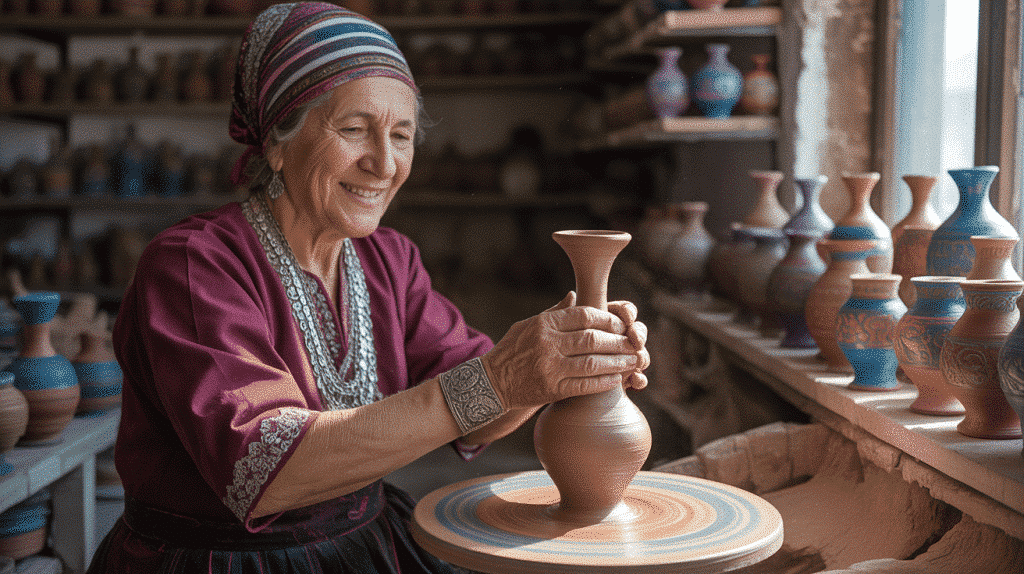Exploring Local Traditions and Customs in Eskişehir
Celebrations, Music, and Dance
One of the most striking aspects of Eskişehir’s culture is its lively celebrations often marked by traditional folk dances such as the Halay. This communal dance, typically performed in a circle, unites participants who join hands and move rhythmically to the beat of the davut and zurna. Such performances are integral to weddings, festivals, and public gatherings, fostering a sense of community and shared joy.
Learning Through Cultural Participation
International students can engage in these vibrant traditions by participating in local events and festivals. These celebrations provide an opportunity to meet locals, make friendships, and get a deeper understanding of Turkish culture.
Traditional Arts and Crafts
Eskişehir is renowned for its craftsmanship, particularly known for meerschaum carving. This soft, white mineral, found locally, is highly valued for creating intricate pipes and ornaments. Students can explore meerschaum art through visits to local museums and artisan workshops, gaining insights into the artisanal techniques and historical significance of this craft.
Glassmaking: A Contemporary Art Form
Moreover, glassmaking is a notable tradition in Eskişehir, showcased at the Museum of Modern Glass Art in the historic Odunpazarı district. This museum not only highlights the craft’s Ottoman roots but also its contemporary interpretations, merging history with modern artistic expression. Engaging with these crafts can offer students a unique way to connect with the culture while developing a greater appreciation for local artistry.
Local Cuisine
A significant aspect of Eskişehir’s allure is its rich and diverse culinary scene, shaped by its multicultural history. Çibörek, a crispy pastry filled with minced meat, onions, and spices, is a local specialty introduced by Crimean and Tatar immigrants.
Sweet Delicacies to Discover
Dessert lovers will find Sivrihisar muska baklavası, a regional variation of the famous syrupy pastry, notable for its triangular shape and traditional preparation style. For those wandering through the picturesque streets, Met helvası, a sweet treat often sold by street vendors, is a must-try, epitomizing the city’s lively urban culture.
Annual Celebrations and Practices
Eskişehir’s annual celebrations are characterized by communal gatherings, music, and an emphasis on shared festivity. The interplay of folk music, artisan crafts, and local cuisine solidifies the city’s commitment to preserving its distinct Anatolian heritage. This rich cultural landscape not only enhances the experience for students but also provides a stimulating backdrop for learning.
Summary Table: Key Customs and Traditions in Eskişehir
| Tradition/Custom | Description |
|---|---|
| Halay Dance | Energetic folk dance performed in a circle, accompanied by davul and zurna. |
| Meerschaum Carving | Unique local craft used for making pipes and ornaments. |
| Glassmaking | Artistic tradition highlighted at the Museum of Modern Glass Art. |
| Atlıhan Crafts Bazaar | Historic bazaar showcasing traditional Turkish handicrafts and souvenirs. |
| Çibörek (Local Cuisine) | Crispy pastry filled with minced meat, reflecting local heritage. |
| Sivrihisar Muska Baklavası | Regional version of baklava, known for its triangular shape. |
| Met Helvası (Street Dessert) | Popular sweet treat sold by local vendors. |
Take the Next Step with Study in Turkiye
As you explore opportunities to study in Eskişehir and embrace its cultural offerings, consider maximizing your academic journey through Study in Turkiye. By connecting with our resources and networks, you can seamlessly navigate the university application process and gain insights into the best institutions that Turkiye has to offer.

